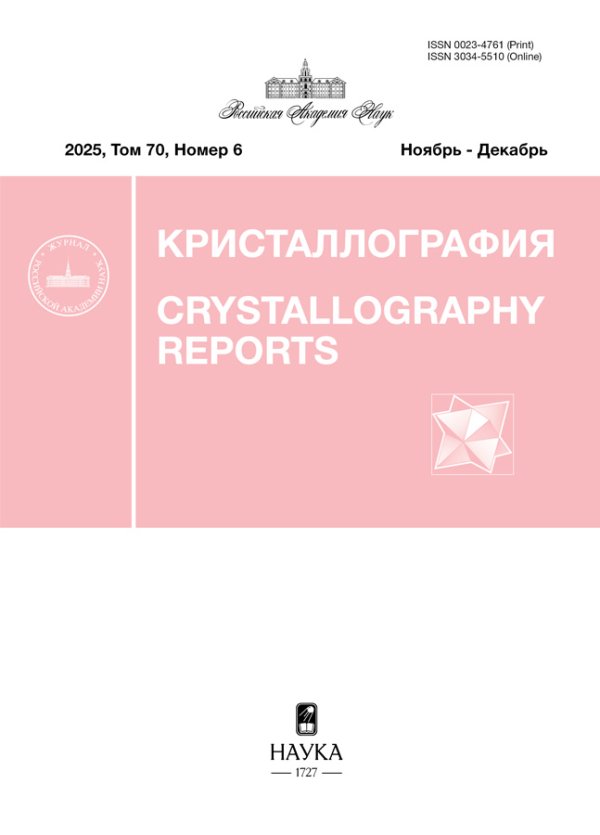Тонкие текстурированные пленки CdTe на подложках из кремния и сапфира: термическое напыление из газовой фазы и структурная характеризация
- Авторы: Кошелев И.О.1, Волчков И.С.1, Подкур П.Л.1, Хайретдинова Д.Р.2, Долуденко И.М.1, Каневский В.М.1
-
Учреждения:
- Институт кристаллографии им. А.В. Шубникова Курчатовского комплекса кристаллографии и фотоники НИЦ “Курчатовский институт”
- Национальный исследовательский технологический университет “МИСИС”
- Выпуск: Том 69, № 2 (2024)
- Страницы: 314-318
- Раздел: ПОВЕРХНОСТЬ, ТОНКИЕ ПЛЕНКИ
- URL: https://journals.rcsi.science/0023-4761/article/view/259742
- DOI: https://doi.org/10.31857/S0023476124020151
- EDN: https://elibrary.ru/YSFTQM
- ID: 259742
Цитировать
Полный текст
Аннотация
Методом термического напыления из газовой фазы выращены тонкие пленки CdTe на подложках Si (111) и Al2O3 (0001). Полученные пленки изучены методами атомно-силовой и растровой электронной микроскопии, а также рентгенофазового анализа. Обнаружено, что на подложках Al2O3 (0001) возможно получение тонких пленок как вюрцитной модификации CdTe, так и сфалеритной. На подложках Si возможно получение тонких пленок сфалеритной модификации CdTe. Показано, что элементный состав тонких пленок близок к стехиометрии, причем в случае тонких пленок, выращенных на Al2O3 (0001), отклонение не превышало 1 ат. %.
Полный текст
ВВЕДЕНИЕ
Теллурид кадмия CdTe является представителем класса широкозонных полупроводников и выделяется среди аналогов по целому ряду свойств. Высокая плотность (5.85 г/см3) и достаточно большие атомные номера элементов, образующих CdTe (48 и 52 соответственно), приводят к высокому коэффициенту фотоэлектрического поглощения [1]. Теллурид кадмия имеет оптимальную ширину запрещенной зоны Е = 1.5 эВ при Т = 300 К [2], поэтому в связи с пределом Шокли–Квиссера он может обеспечить эффективность ~32% при напряжении холостого хода более 1 В и плотности тока короткого замыкания более 30 мА/см2 [3]. При этом солнечные элементы на основе CdTe демонстрируют одну из самых низких стоимостей выработки электроэнергии [4].
CdTe применяется не только в качестве элементов фотоэлектропреобразователей, но и в качестве подложек для нанесения эпитаксиальных слоев CdHgTe, для изготовления чувствительных элементов ИК-детекторов и детекторов рентгеновского и g-излучения.
Для данных применений используются как элементы, изготовленные из объемных кристаллов, так и наноструктурные образцы. К таким образцам предъявляются высокие требования по совершенству. Получение объемных кристаллов методами роста из расплава осложняется интенсивным испарением компонентов и наличием у CdTe целой серии высокотемпературных полиморфных фазовых переходов [5]. Альтернативой объемным кристаллам CdTe являются эпитаксиальные пленки на различных кристаллических подложках (Si, GaAs, Al2O3 и др.). Для получения пленок применяются методы термического напыления из газовой фазы, например, молекулярно-лучевой эпитаксии (МЛЭ) [6–8], химического осаждения [8–10] и лазерной абляции [11, 12]. Для получения высокосовершенных тонких пленок представляет интерес метод МЛЭ, однако ввиду его сложности и ограничений интерес представляет использование близкой к МЛЭ методики термического напыления из газовой фазы.
Поскольку реальная структура пленок в значительной степени определяется условиями роста, исследование структуры и механизмов роста тонких пленок, в том числе на разных подложках, важно для разработки методики получения монокристаллических пленок CdTe. В данной работе проведены исследования состава, структуры и шероховатости поверхности тонких пленок CdTe, выращенных на подложках Si (111) и Al2O3 (0001).
МАТЕРИАЛЫ И МЕТОДИКА ЭКСПЕРИМЕНТА
В качестве объектов исследования использовали тонкие пленки CdTe, выращенные в лабораторной установке по напылению тонких пленок, изготовленной во ФНИЦ “Кристаллография и фотоника” РАН [13], методом термического напыления из газовой фазы с использованием одного источника. Образцы выращивали на подложках Si (111) и Al2O3 (0001) размерм 14 × 8 мм2, вырезанных из стандартных пластин. В качестве материала источника использовали истолченный в порошок монокристаллический CdTe, выращенный модифицированным методом Обреимова–Шубникова во ФНИЦ “Кристаллография и фотоника” РАН [5].
Процесс напыления проходил в условиях вакуума (~10–8–10–7 мбар). Подложки Si и Al2O3 нагревали до температуры ~250°C. Температура источника в обоих процессах составляла 673°C. Время напыления – 60 мин.
Фазовый состав выращенных образцов определяли методом рентгенофазового анализа (РФА) на рентгеновском порошковом дифрактометре X’Pert Pro PANalytical MPD (Нидерланды, CuKα-излучение, λ = 0.154 нм) при комнатной температуре в геометрии Брэгга–Брентано. Диапазон углов 2θ = 20°–80°. Шероховатость и морфологию поверхности выращенных пленок определяли методом атомно-силовой микроскопии (АСМ) на АСМ Solver Pro-M (NT MDT, Россия) в контактном режиме. Элементное соотношение Cd к Te по длине образца определяли методом энергодисперсионной спектроскопии на растровом электронном микроскопе JCM-6000 PLUS (Jeol, Япония) со встроенной энергодисперсионной приставкой.
РЕЗУЛЬТАТЫ И ИХ ОБСУЖДЕНИЕ
Расположение подложки относительно области распыления CdTe в установке термического напыления представлено на рис. 1а. Выращенные образцы тонких пленок CdTe показали соотношение элементов Cd к Te, близкое к стехиометрии (рис. 1б). Образец, выращенный на подложке Si, имел большее отклонение от стехиометрии по длине образца по сравнению с образцом, выращенным на подложке Al2O3, где разброс элементного состава по длине не превышал 1%, за вычетом крайней точки.
Рис. 1. Расположение подложки относительно области распыления CdTe в установке термического напыления (а) и зависимость отклонения содержания Cd (ат. %) от стехиометрии (б)
Методом РФА исследованы три области на выращенных образцах (рис. 1а): 1 – в центре области распыления, 2 – в центре подложки, 3 – на краю области распыления.
Образцы, выращенные на подложках Si (111) (рис. 2а), обладают двумя пиками кубической фазы типа сфалерита CdTe – (111) и (220). Интенсивность пиков (111) увеличивается от края образца к центру, что объясняется увеличением толщины пленки в данном направлении. Это может быть связано с особенностями распыления материала (с градиентом плотности потока распыляемого вещества).
Рис. 2. Рентгеновские дифрактограммы тонких пленок CdTe, выращенных на подложках Si (а) и Al2O3 (б). На врезке – увеличенная область дифрактограммы для тонкой пленки, выращенной на подложке Al2O3, в интервале углов 42°–52°. Номера кривых соответствуют номерам областей на рис. 1а
В случае образца, выращенного на Al2O3 (0001), наблюдается схожая картина (рис. 2б). Интенсивность пиков CdTe изменяется в зависимости от области образца аналогично образцу, выращенному на Si. При этом наблюдаются пики кубической фазы типа сфалерита CdTe (111), (220) и (222), что соответствует эпитаксиальным пленкам CdTe, полученным методом МЛЭ [8]. Причем увеличение интенсивности пиков CdTe на разных областях в случае образцов, выращенных на Al2O3, значительно выше. Также на этих образцах наблюдаются пики гексагонального CdTe: (014) и (113). Пики гексагональной фазы типа вюрцита малы на краю выращенной пленки и наиболее заметны в центральной области, где интенсивность потока распыляемого вещества максимальна. Эти пики являются широкими, что говорит о низкой кристалличности данной фазы. Образование гексагональной фазы CdTe типа вюрцита возможно при росте тонких пленок [14, 15], в том числе благодаря сходству параметров решеток Al2O3 и вюрцитной модификации CdTe (a = 0.475 нм для Al2O3 и a = 0.458 для CdTe). В результате образуется поликристаллическая пленка CdTe, состоящая из вюрцитных и сфалеритных фаз CdTe.
На рис. 3 и 4 представлены АСМ-изображения выращенных пленок. Тонкие пленки CdTe состоят из крупных кристаллитов размером ~500 нм для пленок, выращенных на Al2O3, и ~150 нм для пленок, выращенных на Si. В случае тонких пленок, выращенных на сапфире (рис. 3), присутствуют также крупные кристаллиты размером ~1.5 мкм, имеющие огранку, отличную от основного массива кристаллитов. Соотнося полученные данные с данными РФА-анализа (рис. 2б), можно предположить, что данные кристаллиты могут иметь структуру гексагональной фазы вюрцита CdTe. При этом тонкая пленка CdTe, выращенная на Si, имеет меньшую среднеквадратичную шероховатость (Sq) по сравнению с тонкой пленкой, выращенной на Al2O3. Связано это как с наличием на последней крупных кристаллитов, предположительно гексагональной фазы, так и с большими размерами кристаллитов основного массива. Различие в размерах кристаллитов основного массива связано, предположительно, с разной теплоемкостью материалов подложек Si и Al2O3, что может значительно влиять на процессы кристаллизации.
Рис. 3. АСМ-изображения тонкой пленки CdTe, выращенной на подложке Al2O3 (0001): а, б, в – области 1, 2, 3 соответственно. На врезке – увеличенный вид крупных кристаллитов, предположительно, гексагональной фазы вюрцита
Рис. 4. АСМ-изображения тонкой пленки CdTe, выращенной на подложке Si (111): а, б, в – области 1, 2, 3 соответственно. На врезке – увеличенный вид области 1
ЗАКЛЮЧЕНИЕ
Выращены тонкие пленки CdTe на подложках Al2O3 (0001) и Si (111) методом термического напыления. Тонкая пленка, выращенная на сапфире, является поликристаллической и состоит из двух фаз CdTe: вюрцитной и сфалеритной. При этом образование вюрцитной модификации может происходить в виде процесса вторичной кристаллизации с образованием крупных кристаллитов гексагональной фазы. В случае роста тонких пленок CdTe на кремниевых подложках (111) наблюдается образование ориентированных тонких пленок сфалеритной модификации. Получение тонких пленок CdTe различных модификаций (вюрцитной и сфалеритной) позволит использовать их в качестве подложечного материла для создания многослойных структур с соединениями, имеющими различную кристаллическую решетку. Это значительно расширяет перечень получаемых многослойных структур на основе тонких пленок CdTe. Показано, что полученные пленки имеют состав, близкий к стехиометрическому, при этом тонкая пленка, выращенная на Si, имеет незначительный избыток Te.
Работа проведена в рамках выполнения государственного задания НИЦ “Курчатовский институт”.
Об авторах
И. О. Кошелев
Институт кристаллографии им. А.В. Шубникова Курчатовского комплекса кристаллографии и фотоники НИЦ “Курчатовский институт”
Автор, ответственный за переписку.
Email: iliakoscheleff@yandex.ru
Россия, Москва
И. С. Волчков
Институт кристаллографии им. А.В. Шубникова Курчатовского комплекса кристаллографии и фотоники НИЦ “Курчатовский институт”
Email: iliakoscheleff@yandex.ru
Россия, Москва
П. Л. Подкур
Институт кристаллографии им. А.В. Шубникова Курчатовского комплекса кристаллографии и фотоники НИЦ “Курчатовский институт”
Email: iliakoscheleff@yandex.ru
Россия, Москва
Д. Р. Хайретдинова
Национальный исследовательский технологический университет “МИСИС”
Email: iliakoscheleff@yandex.ru
Россия, Москва
И. М. Долуденко
Институт кристаллографии им. А.В. Шубникова Курчатовского комплекса кристаллографии и фотоники НИЦ “Курчатовский институт”
Email: iliakoscheleff@yandex.ru
Россия, Москва
В. М. Каневский
Институт кристаллографии им. А.В. Шубникова Курчатовского комплекса кристаллографии и фотоники НИЦ “Курчатовский институт”
Email: iliakoscheleff@yandex.ru
Россия, Москва
Список литературы
- Owens A., Peacock A. // Nucl. Instrum. Methods Phys. Res. A. 2004. V. 531. P. 18. https://doi.org/10.1016/j.nima.2004.05.071
- Fonthal G., Tirado-Mejıa L., Marın-Hurtado J.I. et al. // J. Phys. Chem. Solids. 2000. V. 61. № 4. P. 579. https://doi.org/10.1016/S0022-3697(99)00254-1
- Rühle S. // Sol. Energy. 2016. V. 130. P. 139. https://doi.org/10.1016/j.solener.2016.02.015
- Munshi A.H., Kephart J.M., Abbas A. et al. // Sol. Energy Mater. Sol. Cells. 2018. V. 176. P. 9. https://doi.org/10.1016/j.solmat.2017.11.031
- Ivanov Yu.M. // J. Сryst. Growth. 1996. V. 161. № 1–4. P. 12. https://doi.org/10.1016/0022-0248(95)00604-4
- Михайлов В.И., Поляк Л.Е. // Поверхность. Рентген., синхротр. и нейтр. исслед. 2021. Т. 7. C. 43. https://doi.org/10.31857/S102809602107013X
- Zhang S., Zhang J., Qiu X. et al. // J. Cryst. Growth. 2020. V. 546. P. 125756. https://doi.org/10.1016/j.jcrysgro.2020.125756
- Михайлов В., Буташин А., Каневский В. и др. // Поверхность. Рентген., синхротр. и нейтр. исслед. 2011. Т. 6. C. 97.
- Ramanujam J., Bishop D., Todorov T. et al. // Prog. Mater. Sci. 2020. V. 110. P. 100619. https://doi.org/10.1016/j.pmatsci.2019.100619
- Dharmadasa I., Echendu O., Fauzi F. et al. // J. Mater. Sci.: Mater. Electron. 2017. V. 28. P. 2343. https://doi.org/10.1007/s10854-016-5802-9
- Quintana-Silva G., Sobral H., Rangel-Cárdenas J. // Chemosensors. 2022. V. 11. № 1. P. 4. https://doi.org/10.3390/chemosensors11010004
- Quiñones-Galván J., Camps E., Campos-González E. et al. // J. Appl. Phys. 2015. V. 118. № 12. P. 125304. https://doi.org/10.1063/1.4931677
- Гельман Ю., Дымшиц Ю., Самохвалов Ю. и др. // Приборы и техника эксперимента. 1994. № 5. C. 181.
- Jiménez-Sandoval S., Meléndez-Lira M., Hernández-Calderón I. // J. Appl. Phys. 1992. V. 72. № 9. P. 4197. https://doi.org/10.1063/1.352230
- Zanio K. Semiconductors and Semimetals. V. 13. New York: Academic press, INC., 1978. 235 p.
Дополнительные файлы














